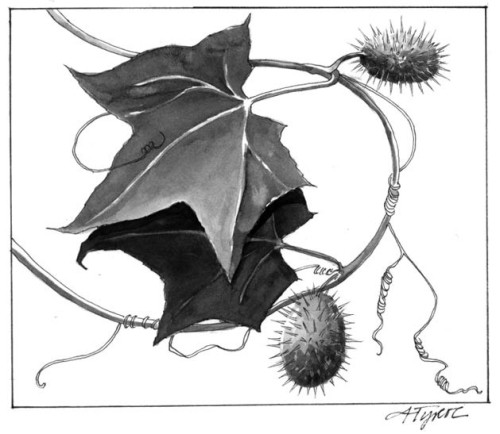
There is a plant found near streams and rivers in our area that has almost magical properties for little boys. It is almost as if grown-ups can’t see it. Little girls see the plant differently and may, like adults, overlook it entirely unless its most significant feature has just whacked them in the head.
I’ve heard the fruit of this plant called “prickly pods” and “cactus balls.” My daughter insists on “mini cactus.” Yesterday, two 8-year-old boys told me a story about its name that was almost identical to one I read on the Internet a month ago. “Porcupine eggs!” a conspiratorial adult had told them when they had asked what the plant was. They thought that was really funny.
“Prickly cucumber” is the common name of this plant, which works for me. It is also known as wild cucumber and wild balsam apple.
The plant is a vine with greenish white flowers and leaves that are sometimes described as maple-like, but to me they look more like a sweet gum leaf, since the leaves have pointier “fingers” and less of a “palm” than the leaves of a sugar maple.
But it’s the fruit of this plant that makes it more than just another streamside vine. The prickly cucumber has an oval, prickly fruit about 2 inches long that dangles down. While it is called “cucumber” and is related to the eating variety of cucumber, it’s a distant relative. Prickly cucumbers are clearly not for eating. There is no way you would want to put a prickly cucumber in your mouth. Its outsides, at best, resemble a kiwi fruit. At worst, they look like something that should swing from a stick as a weapon for a really small medieval knight.
Its insides are stringy, like a loofah sponge with a few watermelon seeds in it. It doesn’t say “eat me,” it says “exfoliate.”
A similar-looking, similar-sounding plant grows in the same habitat as the prickly cucumber. The difference is subtle. The bur cucumber has a cluster of grape-sized, prickly fruits. The prickly cucumber’s fruit is larger and grows alone. The bur cucumber looks like a bur. The prickly cucumber is distinctly more egg-like in size and shape. It really is no wonder people call them porcupine eggs.
The scientific name of the prickly cucumber is Echinocystis lobata, which is Greek for ‘lobed hedgehog bladder’. This is where the girls come in. “Lobed” is for the leaf of the plant. “Bladder” is for all those empty spaces in the loofah-like interior of its fruit. The hedgehog actually comes from the Greek word for spiny. When the fruit has dried, its prickles relax a little, and it looks even more like a tiny porcupine or hedgehog.
One girl I know likes to keep them around as a sort of pet. While not exactly cuddly, they are quiet, fit nicely in a pocket, and you don’t have to clean up after them.
Last fall, prickly cucumbers were all the rage, as both weapons and pets, at both of my children’s schools. I had never seen them before, but Bob Popp, the botanist for the Vermont Nongame and Natural Heritage program, tells me that, as an annual, the prickly cucumber’s populations are likely to vary from one year to the next “depending upon conditions the previous year being favorable to fruit production [or not] and conditions of the current year being favorable to germination [or not].”
I wonder if last year’s hot, wet summer had anything to do with the bumper crop of prickly cucumbers. The prickly cucumber is one of the northernmost members of its mostly tropical extended plant family, which includes cucumbers, pumpkins, melons, squashes, and, yes, loofah sponges. It is native in our area. It grows in nearly all parts of Vermont and New Hampshire, except for the far northern reaches. It grows, as a native, as far south as Florida and Texas. On the West Coast, it is a pesky invasive.
Fall is the best time of year for identifying the prickly cucumber, because, as other foliage withers and falls away, the cucumbers suddenly appear, hanging from vines atop fences and shrubs. Young boys are particularly adept at locating the small fruits, especially in years when crabapples and other missiles are in short supply. The fruits will linger on the vine after the first frost and are best spotted in September and October.
But if the boys find them first – take cover.

